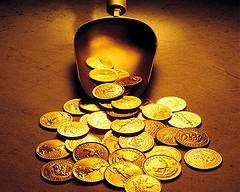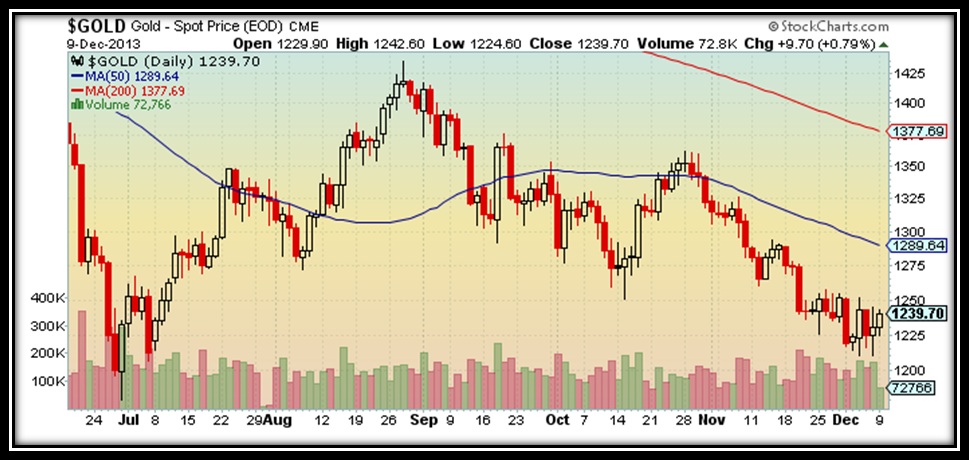Gold Update
While major Western Governments try everything to preserve their Fiat Currencies, China continues to accumulate more Gold Bullion. 
In spite of a string of strong economic data from the US, the dollar failed to stage a solid rally against other major currencies last week, and the price of gold found support above $1200 an ounce.
The global gold market was relatively choppy during the week as traders awaited the latest employment report from the US as well as other economic data and a decision from the European Central Bank (ECB).
As to be expected, the price of gold dropped initially on the latest US non-farm payroll report but soon bounced off the lows of $1211 an ounce. And, once again, as Nanex showed, the price of gold fell a mere seven seconds before the report was released. On December 6, 2013, at 8:29:53, which was seven seconds before the 8:30 AM scheduled release of the latest employment numbers, the price of gold as measured by the February 2014 (GC) futures contract plummeted almost $6 on about 600 contracts traded in 50 milliseconds.
At 1.6 seconds before the news release, about 2,000 March 2014 5-Year T-Note Futures contracts sent prices down so fast, that trading halted for 5 seconds: which included the time of the news release. The same thing happened during the Employment numbers release in June.
Meanwhile, the Dow Jones and S&P recently made new all-time highs. The DOW rebounded strongly after dropping to as low as 15791 and closed above the 16000 handle at 16020. At the same time the S&P 500 also closed back above 1800 level at 1805. The yield on the US 30 year note closed at new high of 3.917% and the yield on the 10 year note also closed higher at 2.883%.
Over the weekend, it was reported that China had its biggest trade surplus in almost five years. In November, China's trade surplus rose to $33.8 billion from $31.1 billion the month before. Exports staged a rebound, rising 12.7% from November last year, well ahead of October's 5.6% growth. But, imports grew a more modest 5.3% year-over-year.
While China’s foreign exchange reserves increase to a whopping $3.6 trillion, many US government officials as well as leading business personalities have labelled the Chinese currency manipulators. But, it seems that the US financial policy makers, together with their banking cronies and leading business people are the real culprits here as they have attempted to manipulate interest rates, currencies, energy prices, while suppressing the price of gold and silver. Not to mention how they cheated their own clients by selling them toxic mortgages. And, now the US Fed has flood the financial system with easy money causing various different classes of assets to rise while debasing their own currency.
There is a complete disconnect with the value of the greenback, US Treasury yields and the price of gold. Under normal conditions, a strong economy as reflected in rising stock prices would increase the value of the respective currency and yields on government bonds should be stable reflecting a low risk environment. However, in the US, as prices of stocks continue to rise, the US dollar is not gaining value against its major peers and Treasury yields have been edging higher. I believe this is sign that investors are not convinced about the current situation. I expect to see the yield on the benchmark 10-Year Treasury hit 3% soon. In the meantime, the price of gold has fallen to almost $1200 an ounce.
On Friday, the US Labour Department reported that non-farm payrolls increased by as much as 203,000. And, the October figure was revised upwards to 200,000. November’s employment gain was the biggest in three months. The median forecast of 89 economists surveyed by Bloomberg called for a 185,000 advance, with estimates ranging from increases of 115,000 to 230,000. The participation rate increased 63% in November, the first gain since June. A month earlier it fell to 62.8%, the lowest level since March 1978.
The unemployment rate dropped to a five-year low of 7% in November, boosting speculation the US Federal Reserve may start to taper its monetary stimulus as soon as this month.
Policy makers at the Fed, who next meet on December 17-18, have said they will keep buying bonds in a bid to lower long-term borrowing costs until the outlook for the job market has “improved substantially.” At the same time, Fed Chairman Ben Bernanke has said the benchmark interest rate will remain low at least as long as the jobless rate is above 6.5 percent.
In other economic news, US third quarter GDP growth was revised up, the number of new applications for unemployment benefits fell by 23,000 last week to 298,000, and manufacturing conditions improved in November to their best level in more than two years.
The Institute for Supply Management’s manufacturing index climbed to 57.3% from 56.4% in October, reaching the highest level since April 2011.
The strong economic data has reinforced the case that Fed will taper their programme of buying $85 billion per month of Treasury and mortgage-backed securities. So, it will be interesting to see what the Fed decides to do, if anything, in their upcoming meeting.
At the latest meeting held by the ECB, President Mario Draghi said that The European Central Bank will keep its benchmark rate unchanged at a record low after policy makers assessed new economic forecasts. The Governing Council meeting in Frankfurt left the main refinancing rate at 0.25% after cutting it by one quarter basis point last month.
The Bank of England also kept its benchmark rate at 0.5%, and left its asset-purchase target at 375 billion pounds ($613 billion).
As policy makers and government officials of the major Western economies continue to shun gold as they attempt to preserve their current fiat currencies, China has been buying massive amounts of gold.
According to Hong Kong customs data, China imported 148 tons of gold in October which was the second highest monthly import ever through Hong Kong, second only to the 224 tons imported in March of 2013. Compared to a year ago, when the price of gold was over 30% higher, China has imported over 200% more than the 48 tons it bought through Hong Kong a year ago.
On a net basis, October was also the second busiest month for Chinese gold imports, soaring to a near record 131.2 tons, second only to March's 136.2 tons, and represents the sixth consecutive month in which China has imported more than 100 tons of gold net of exports.
These numbers of course exclude gold procured in China using other means, such as imports via other venues, as well as internally produced gold.
While it is difficult to calculate exact figures, it appears that China has bought in excess of 1200 tons already this year. If the figures are correct it seems that since September 2011, China has imported a whopping 2380 tons of gold. And, since 2009, the Shanghai Gold Exchange has delivered more than 8000 tons!
According to an article published by Reuters, China's Yuan also known as the renminbi has become the second-most used currency in trade finance, surpassing the euro.
The market share of Yuan usage in trade finance, or Letters of Credit and Collection, grew to 8.66% in October 2013. That improved from 1.89% in January 2012.
The Yuan now ranks behind the U.S. dollar, which remains the leading currency with a share of 81.08%.
The top five countries using the Yuan for trade finance in October were China, Hong Kong, Singapore, Germany and Australia, SWIFT said in a statement.
The world's second-largest economy is accelerating the pace of financial reform to promote its currency to international players beyond Hong Kong. China aims to lift the Yuan’s global clout and reduce its reliance on the U.S. dollar. It is also believed that the renminbi will eventually have some sort of gold backing.
Interestingly, while major Western banks have been found guilty of one transgression after another, I don’t believe that any Chinese bank participated in these devious schemes. And, when it comes to gold, I will follow the Chinese and not the US. I will take advantage of these lower prices to buy more and not to sell. I also believe that the price of gold has made its lows for the year.
TECHNICAL ANALYSIS
Gold prices have found solid support above the $1200 an ounce level. I expect to see further consolidation but believe that prices have completed the correction which began in September.
For more information go to: www.lakeshoretrading.co.za


















